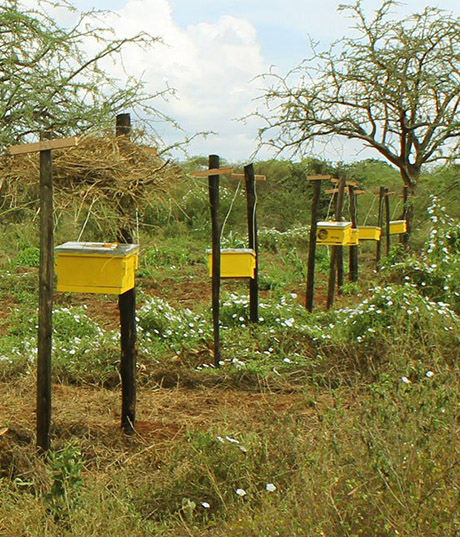
Gratuitous cute elephant photograph by Brian Snelson.
Edible Geography readers have perhaps heard of “pollinator pathways,” an initiative to thread together isolated pockets of green space into nectar-filled corridors, in order to give butterflies and bees easier passage across otherwise unfriendly urban expanses of concrete and asphalt. A recent article in British Airways’ High Life magazine about efforts to save Kenya’s last remaining elephants introduced me to an interesting twist on the concept of bee-based landscape design: “honey fences.”
Although the main threat to the elephants’ survival is ivory-market driven poaching, a significant number are also killed each year following altercations with local villagers. As Angela Carr-Hartley, director of the David Sheldrick Wildlife Trust, politely put it, “These communities have mixed feelings about an elephant coming into their smallholdings overnight, as they can wreak havoc eating the crops.”

Beehive fence, photo via The Elephant and Bees Project.
Zoologist Lucy King came up with the honey fence solution, which takes advantage of the fact that elephants are terrified by the sound of bees. (The delicate skin inside their trunks is apparently particularly vulnerable to being stung.) King had read that elephants tend to avoid acacia trees, usually a favorite food, if bees have built a hive in the branches. Based on that initial insight, and after several years of behavioral experiments, including playing elephants the sound of disturbed bees from a hidden loudspeaker and filming their reaction, King developed the honey fence system: a series of hives, suspended at ten-metre intervals from a single wire threaded around wooden fence posts. If an elephant touches either a hive or the wire, all the bees along the fence line feel the disturbance and swarm out of their hives in an angry, buzzing cloud.
A pilot honey fence in 2009 proved successful, deterring all but one bull elephant, and The Elephants and Bees Project has since spread to sites across Africa. Neville Sheldrick of the David Sheldrick Wildlife Trust told Africa Geographic that nearby farmers are sure the fence is working: “When I visit they proudly walk me around showing me the footprints of elephants that have walked up to and along the fence in several locations before turning back towards the park.”
By encircling a village with a cordon of hives, the village’s crops are protected, the elephants steered away from potential conflict, and, adds Carr-Hartley, “the farmers are able to garner some revenue from the harvesting of honey.” The result of truly delightful example of interspecies landscape engineering, jars of “Elephant-friendly” honey are for sale at The Elephant and Bees Research Centre in Tsavo, Kenya.

